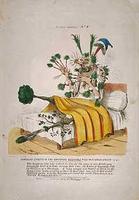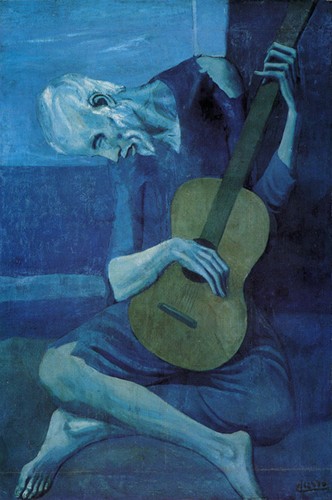Some highlights:
Victor Hugo
 The biggest surprise of all was discovering that in addition to being the incredible novelist that he was, Victor Hugo (yup, the Les Miserables guy) was also an artist, and an incredibly good artist at that. Done in brown ink and pen, his drawings combine a dark, brooding quality with great subtlety in shading and the slightest hint of abstraction. I'm attaching an example (not unfortunately, one of the Prat collection drawings, but the ones there are fairly similar; this one is called The key is here, the gate elsewhere). This is really, really impressive stuff, and one of those rare examples of someone spanning multiple art forms successfully (other examples I can think of - Tagore has some decent paintings on display at the NGMA at Delhi, plus there's the poet Weldon Kees, who's work actually featured in exhibitions along with Picasso!)
The biggest surprise of all was discovering that in addition to being the incredible novelist that he was, Victor Hugo (yup, the Les Miserables guy) was also an artist, and an incredibly good artist at that. Done in brown ink and pen, his drawings combine a dark, brooding quality with great subtlety in shading and the slightest hint of abstraction. I'm attaching an example (not unfortunately, one of the Prat collection drawings, but the ones there are fairly similar; this one is called The key is here, the gate elsewhere). This is really, really impressive stuff, and one of those rare examples of someone spanning multiple art forms successfully (other examples I can think of - Tagore has some decent paintings on display at the NGMA at Delhi, plus there's the poet Weldon Kees, who's work actually featured in exhibitions along with Picasso!)Prud'hon
 Pierre-Paul Prud'hon is a painter I'd frankly never heard of till yesterday - but the paintings of his on display in the Prat collection are truly amazing. Painted on blue paper (apparently a favourite of many artists while making drawings), these drawings have a luminous, moonlight quality about them. They seem soaked in blue like nothing I've ever seen outside of Picasso, and yet there's somehow the faintest hint of light lying subdued under the surface, so that the overall drawing has a eerie, dream-like feel. The draftsmanship is superb, moreover, the human figures a little stylised, but nevertheless sublimely graceful. The only one of the four drawings that are part of the Prat collection that I could find online is this one - called Fortune - a good drawing, but not, alas the best of the lot (also, you can't actually see the light effect in computer copies - you need to see the original to understand how fragile, how delicate the shading really is)
Pierre-Paul Prud'hon is a painter I'd frankly never heard of till yesterday - but the paintings of his on display in the Prat collection are truly amazing. Painted on blue paper (apparently a favourite of many artists while making drawings), these drawings have a luminous, moonlight quality about them. They seem soaked in blue like nothing I've ever seen outside of Picasso, and yet there's somehow the faintest hint of light lying subdued under the surface, so that the overall drawing has a eerie, dream-like feel. The draftsmanship is superb, moreover, the human figures a little stylised, but nevertheless sublimely graceful. The only one of the four drawings that are part of the Prat collection that I could find online is this one - called Fortune - a good drawing, but not, alas the best of the lot (also, you can't actually see the light effect in computer copies - you need to see the original to understand how fragile, how delicate the shading really is)
Boucher
I've always been a big admirer of Boucher, and this collection only makes my fondness for him stronger. The exhibition opens with one of his works - a glorious Bacchus done in flowing grey with warm, orange tones. But the real masterpiece in my opinion is a sketch of Saul driving David from his court - the figures here are forms of pure energy, the composition is superb (with David, in clear, confident lines to the right, set against the milling, indignant figures on the left), the drawing manages to convey a sense of high drama without showing you any real detail of faces / gestures. Beautiful.
Seurat
 Perhaps the master whose work comes out most forcefully in the exhibition, though, is Seurat. Black and white may well by the best setting to show off the marvellous intensity and incredible skill that Pontillism involves. Deprived of colour, Seurat has only shade (achieved by pressing the charcoal to the paper with different levels of pressure) to work with, and the fact that he still manages to create images of the most intense fragility and yearning is a true testament to his incredible talent. His drawings here have the grainy quality of truth, of beauty seen through a haze, of old newspaper photographs. My favourites included Haunted House and this drawing of a Bootblack with his customer.
Perhaps the master whose work comes out most forcefully in the exhibition, though, is Seurat. Black and white may well by the best setting to show off the marvellous intensity and incredible skill that Pontillism involves. Deprived of colour, Seurat has only shade (achieved by pressing the charcoal to the paper with different levels of pressure) to work with, and the fact that he still manages to create images of the most intense fragility and yearning is a true testament to his incredible talent. His drawings here have the grainy quality of truth, of beauty seen through a haze, of old newspaper photographs. My favourites included Haunted House and this drawing of a Bootblack with his customer.
Delacroix
Finally, the one other master I was truly impressed by in this exhibition was Delacroix. I've never been a major fan of Delacroix's work. I like the rich texture of his paintings, the warmth of his colours, the beauty of his figures, but the themes he uses often make me impatient, and in general I've never really found anything truly exceptional in his work. The drawings featured here, though, showed me a different side of Delacroix - a more free-wheeling yet intense side, a painter more willing to experiment and take beauty where he can find it. I was particularly impressed by a sketch of a knight sitting on the ground with an angel above him - it's a really small print, done in almost abstract outline, the lines cursive enough to be handwriting. The two figures are merely suggested here - they emerge from what seems to be an almost random series of scribbles. You have the sense of a man trying to get his thoughts together. An amazing find. (the painting this reminded me most of was a tiny Picasso sketch of a Harlequin I saw at another exhibition once - a harlequin made with quick, flowing lines of a fountain-pen)
Others
Other highlights included: a couple of beautiful Cezannes, the clarity of the lines that would make him the great master he became already visible; a light-as-air Degas, sketched in simple diagonal lines reminiscent of Da Vinci, making you wonder if there was anything that Degas could not do; a couple of sensitive Millet (oh, ya, he's there too), in particular a sketch of a peasant woman with her face done in exquisite, trembling detail; a gorgeous Fragonard, a brilliant example of how even a black and white drawing can be filled with the richness of colour and texture; a few Ingres, breathtaking in their simplicity; a drawing of Minerva (Athena?) hunting down a Harpie, a glorious mid-air battle scene taken from a front perspective so that the Harpie seems to be falling towards you; a superbly lit vision of St. Peter healing the sick with shadows; a gorgeously warm Watteau; and a single Manet drawing with half of the figure gloriously shaded, while the other half is merely suggested by outline. Oh, and a hauntingly dark portrait of his son and daughter-in-law seated at his deathbed by Jean-Pierre David, apparently the last drawing he ever made, a wonderful study in despair.
Overall, it was a really exciting exhibition, helped by the fact that it was members-only so the hall was almost completely empty (plus I got to be a snob and do the "oh, I'm a member" act).
 Also checked out a couple of other exhibitions that were on display at the museum. There was one particularly fine one of Hopper's prints. Apparently Hopper did commercial illustrations and made prints before he turned to painting. These prints therefore represent some of his earliest works, but his preoccupation with (and genius for) scenes of aching beauty from simple everyday life is already evident (see for instance, this painting, Night on the El). The black and white nature of print making only enhances the starkness of Hopper's vision (it's not like his use of colour is that stunning anyway) making the urban world he describes for us truly a place of shadow and light.
Also checked out a couple of other exhibitions that were on display at the museum. There was one particularly fine one of Hopper's prints. Apparently Hopper did commercial illustrations and made prints before he turned to painting. These prints therefore represent some of his earliest works, but his preoccupation with (and genius for) scenes of aching beauty from simple everyday life is already evident (see for instance, this painting, Night on the El). The black and white nature of print making only enhances the starkness of Hopper's vision (it's not like his use of colour is that stunning anyway) making the urban world he describes for us truly a place of shadow and light.
 The other interesting exhibition on display was this thing called Quack, Quack, Quack, which featured posters and paintings that dealt with the early medical profession and the prevalance of quacks and outlandish cures. It was a pretty fun exhibition, showcasing both advertisements for some of these products and services as well as the cartoons, caricatures and other art works making fun of or criticising the medical profession. The attached print, called The singular effects of the Universal Vegetable Pills on a Green Grocer, is a classic example.
The other interesting exhibition on display was this thing called Quack, Quack, Quack, which featured posters and paintings that dealt with the early medical profession and the prevalance of quacks and outlandish cures. It was a pretty fun exhibition, showcasing both advertisements for some of these products and services as well as the cartoons, caricatures and other art works making fun of or criticising the medical profession. The attached print, called The singular effects of the Universal Vegetable Pills on a Green Grocer, is a classic example.
The real find at this exhibition for me though, was an incredible print by Callot of the Fair at Impruneta (see below) which is this amazingly detailed drawing with literally hundreds upon hundreds of tiny human and animal figures, yet each one is sketched in painstaking detail, is involved in some specific activity and is amazingly lifelike, even at so miniscule a level. You could study this painting for hours and still not see every little detail that Callot has put there. Amazing.





No comments:
Post a Comment